2011年11月30日
Shikoku Mura Outdoor Historical Museum
One of my "must-see" spots in Takamatsu is located at the foot of Mount Yashima: Shikoku Mura, a little village right out of ye olde Japan. In terms of the artistry of arrangement, Shikoku Mura far surpasses any other historical museum I've seen.

At the moment, there are thirty-three reconstructed buildings, some of which are several centuries old and 17 of which have been designated as important cultural properties or assets. They are nestled among trees and fields of flowers, making this museum a great nature walk as well.
Paper hut (2)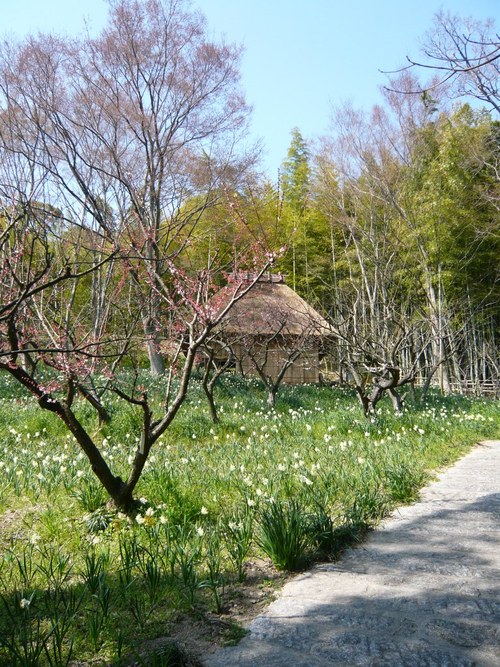
Rugged footpaths lead visitors up and around the steep slope,
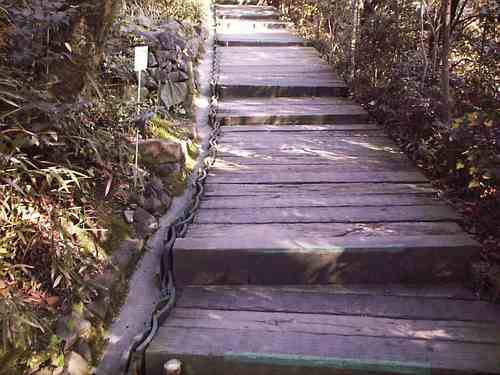
allowing them to stumble upon buildings in unexpected places; such as –
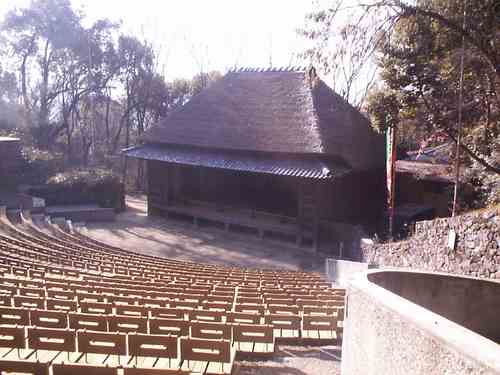
this kabuki theater,

a sugar shack,

and a papermaking hut.
The stone path up from the entrance leads to a suspension bridge which, except for the wire cable reinforcing it, is a faithful replica of those once used to cross breathtaking drops in the mountains of Shikoku's interior. (There's a way around it for the faint of heart.)
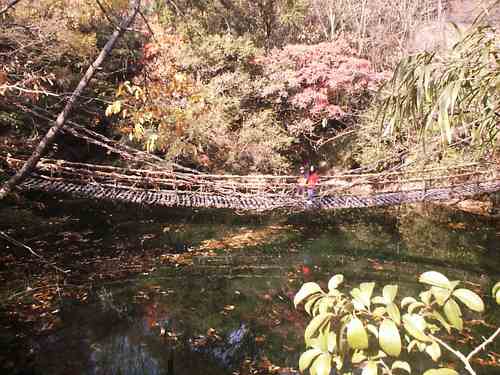
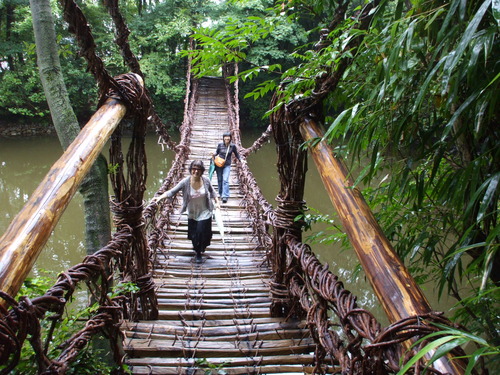
A stream meanders along another path, past mountain farmhouses and an inventor's home, and culminates in a beautiful waterfall and pond.

Waterfall in 1987
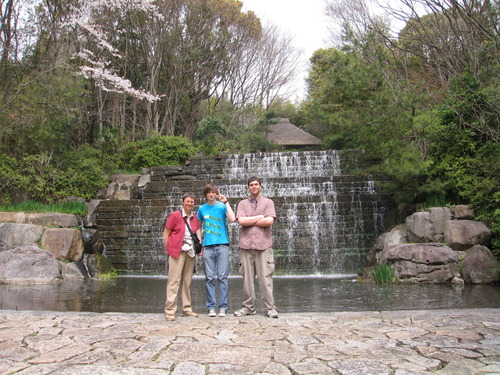
And 20 years later (with different people!)
If I remember correctly, the lotuses in this pond are an ancient species cultivated from excavated seeds. Much of the stonework, as well as the fountain and waterfall, were designed by sculptor Masayuki Nagare and built by the area's superb stonemasons. The stones were reused from such things as old building foundations.
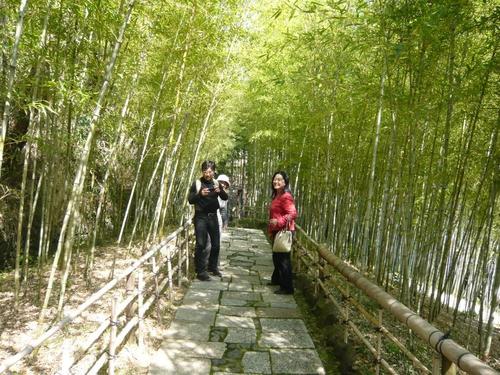
It's really a lovely hike of discovery that takes about an hour and a half or longer if you want to enjoy the flowers or examine the thousands of tools and implements. The English signs are very readable and informative, an added bonus as this is not always the case in Japan!
A visitor demonstrating his strenght with the strength-testing stones
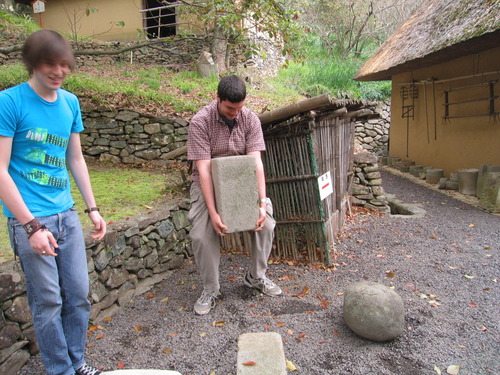
Another visitor who was less successful.
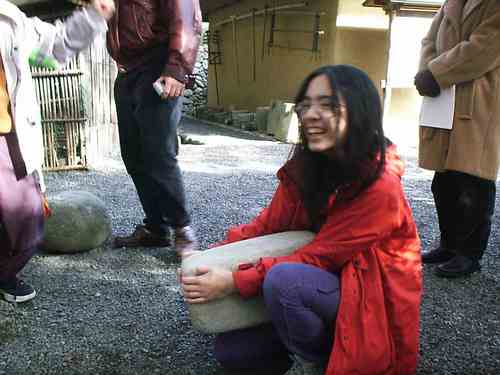
Several of the buildings such as the kabuki theater and the inventor Michitaka Kume's house are used to host educational and social events and concerts, and can also be rented by private groups.
Just outside the museum, there are two restaurants, also housed in beautiful traditional architecture: the popular udon shop, Waraya, and the European-style tearoom, Ijinkan relocated from Kobe. Both provide an excellent finishing touch to a beautiful hike. The tearoom hosts concerts so you can enjoy music with tea and cake.
Shikoku Mura is a great place to experience traditional Japanese culture and history and the influence of other cultures upon it - and all within a beautiful natural setting.
Hours and Fees
Hours: 8:30 to 17:30 (until 18:00 from April to October)
Open year round.
Admission: 800 yen for park only; 1000 yen for a combined park and art gallery ticket
Restaurants: Also open year round, 10:00-19:00 (18:30 in winter) on weekdays 9:00-19:00 on holidays/weekends for the Ijinkan and 9:30-17:30 (March 1 - Nov. 23) and 9:30-17:00 (Nov. 24-end Feb.) for Waraya.
Access:
By Kotoden: Take a train from Takamatsu-Chikko Station to Kawaramachi Station (4 min., frequent departures) and transfer to the Shido Line. Get off at Kotoden Yashima Station (13 minutes, 3 trains/hour). Total time: about 20 minutes. Cost: 310 yen. It’s a 5-minute walk from the station.
By JR: Take a local train from JR Takamatsu Station in the direction of Tokushima. Get off at Yashima Station (15 minutes, 210 yen, 2 trains/hour). It’s a 15-minute walk from the station.
Website: http://www.shikokumura.or.jp/ (Japanese only)

At the moment, there are thirty-three reconstructed buildings, some of which are several centuries old and 17 of which have been designated as important cultural properties or assets. They are nestled among trees and fields of flowers, making this museum a great nature walk as well.
Paper hut (2)
Rugged footpaths lead visitors up and around the steep slope,

allowing them to stumble upon buildings in unexpected places; such as –

this kabuki theater,

a sugar shack,

and a papermaking hut.
The stone path up from the entrance leads to a suspension bridge which, except for the wire cable reinforcing it, is a faithful replica of those once used to cross breathtaking drops in the mountains of Shikoku's interior. (There's a way around it for the faint of heart.)

A stream meanders along another path, past mountain farmhouses and an inventor's home, and culminates in a beautiful waterfall and pond.

Waterfall in 1987
And 20 years later (with different people!)
If I remember correctly, the lotuses in this pond are an ancient species cultivated from excavated seeds. Much of the stonework, as well as the fountain and waterfall, were designed by sculptor Masayuki Nagare and built by the area's superb stonemasons. The stones were reused from such things as old building foundations.
It's really a lovely hike of discovery that takes about an hour and a half or longer if you want to enjoy the flowers or examine the thousands of tools and implements. The English signs are very readable and informative, an added bonus as this is not always the case in Japan!
A visitor demonstrating his strenght with the strength-testing stones
Another visitor who was less successful.

Several of the buildings such as the kabuki theater and the inventor Michitaka Kume's house are used to host educational and social events and concerts, and can also be rented by private groups.
Just outside the museum, there are two restaurants, also housed in beautiful traditional architecture: the popular udon shop, Waraya, and the European-style tearoom, Ijinkan relocated from Kobe. Both provide an excellent finishing touch to a beautiful hike. The tearoom hosts concerts so you can enjoy music with tea and cake.
Shikoku Mura is a great place to experience traditional Japanese culture and history and the influence of other cultures upon it - and all within a beautiful natural setting.
Hours and Fees
Hours: 8:30 to 17:30 (until 18:00 from April to October)
Open year round.
Admission: 800 yen for park only; 1000 yen for a combined park and art gallery ticket
Restaurants: Also open year round, 10:00-19:00 (18:30 in winter) on weekdays 9:00-19:00 on holidays/weekends for the Ijinkan and 9:30-17:30 (March 1 - Nov. 23) and 9:30-17:00 (Nov. 24-end Feb.) for Waraya.
Access:
By Kotoden: Take a train from Takamatsu-Chikko Station to Kawaramachi Station (4 min., frequent departures) and transfer to the Shido Line. Get off at Kotoden Yashima Station (13 minutes, 3 trains/hour). Total time: about 20 minutes. Cost: 310 yen. It’s a 5-minute walk from the station.
By JR: Take a local train from JR Takamatsu Station in the direction of Tokushima. Get off at Yashima Station (15 minutes, 210 yen, 2 trains/hour). It’s a 15-minute walk from the station.
Website: http://www.shikokumura.or.jp/ (Japanese only)
Posted by cathy at
16:07
│Comments(0)
2011年11月29日
Islands, Art and Octopi
Hearing that the art sites on Ogijima were going to close down for the winter, my husband and I impulsively hopped aboard a ferry on the very last day. We almost didn't go because it was cold and raining. "We’ve seen all the sites already. Is it worth the trouble?" we thought, but in the end we were glad we went.
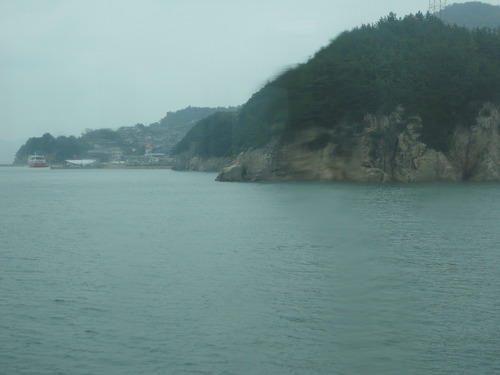
Ogijima in the rain, looking wet but still beautiful.
We arrived in mid-afternoon just as 130 people were leaving. Apparently there had been a big event with hoards of kids and families reminiscent of Art Setouchi in 2010. The onba market was out with local women selling food and handmade crafts from their custom-made art buggies.

Onba Market
We bought octopus rice, tempura and soybeans – all excellent and reasonably priced. The men were selling local fish, octopus and crabs, live!
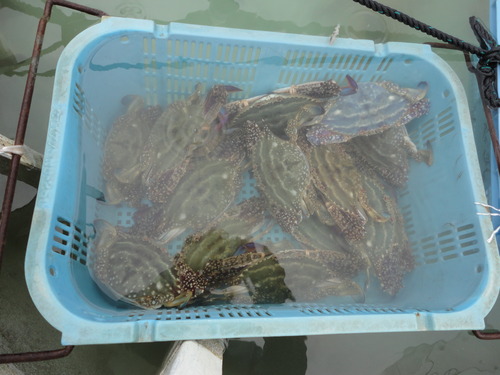
Local crabs
I caught this man butchering an octopus on the spot for a customer.
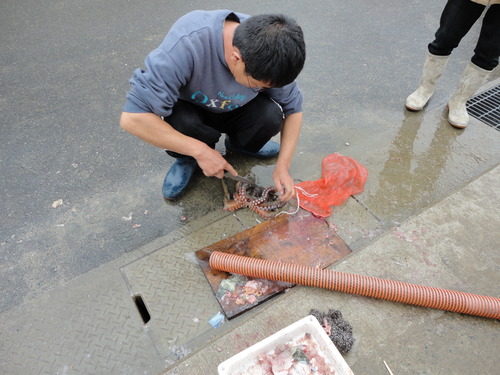
According to him, octopi have several hearts so they don't die very easily. This one tried to escape up the butcher's leg despite being partly butchered already.


It didn't succeed. A pretty gruesome business really. We bought live crabs instead and cooked them when we got home. These local crabs can't be bought in stores because select restaurants that know how good they are buy them up. They were delicious but cooking them live was still a bit gruesome.

Cooked crab.
After shopping, we wandered through the now familiar lanes to the art sites. Arriving at Dream Friends, we were delightfully surprised to find the art space transformed by the works of a local artist named Tadataka Mizutani.
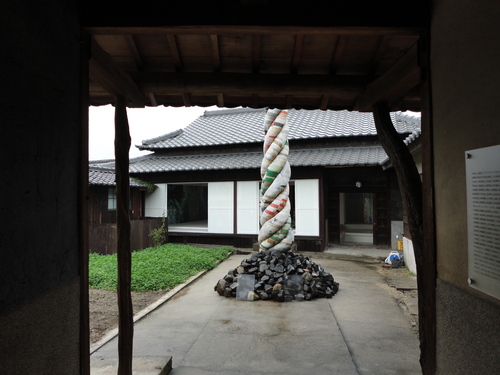

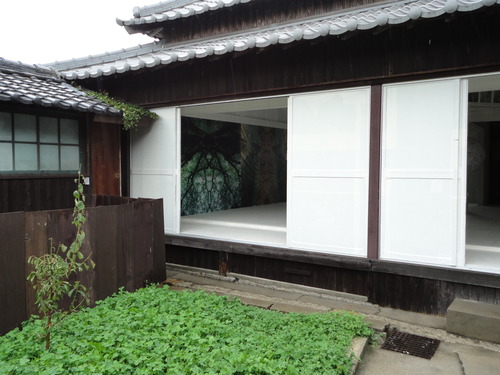
I'm not sure how much comes through from these photos, but the vivid greens and blues in the white washi-papered setting seemed to mirror the colors of the outer world, drawing us inside. It was quite magical.

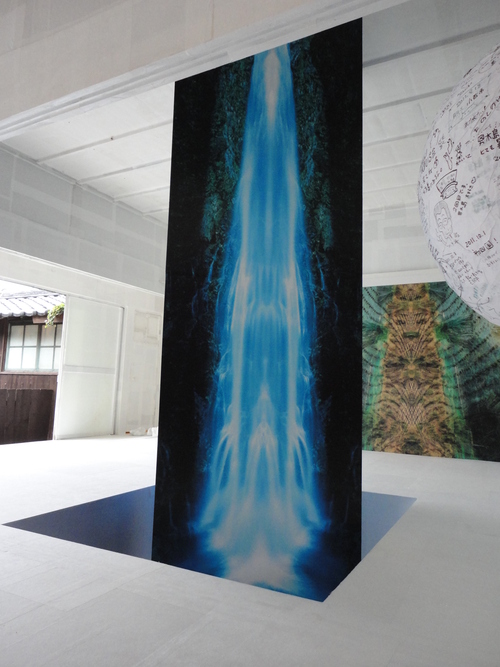

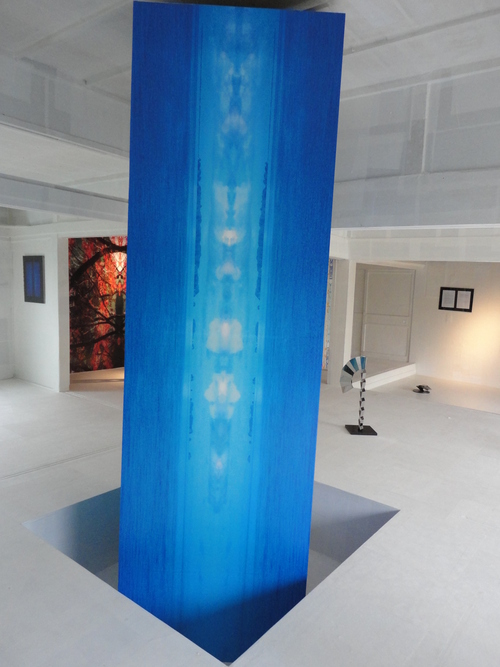
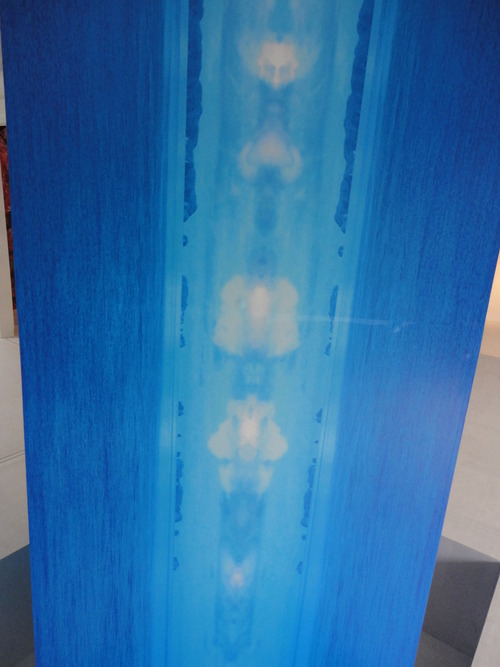
The above are from a stunning series of mirror image photos made for the 2003 Kyoto World Water Forum. Below are some of Mizutani’s graceful stainless steel sculptures.


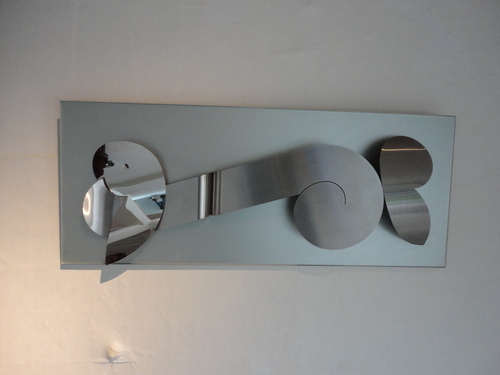
His wife happened to be there and she told us that he had submitted a proposal to Art Setouchi 2010 but had passed away a year before the festival at only 54 years of age. This was a beautiful tribute to his work.
Another pleasant surprise for us was Sea Vine. Being a gray day, they had turned the lights on in the building. It was the first time I had ever seen it lighted.
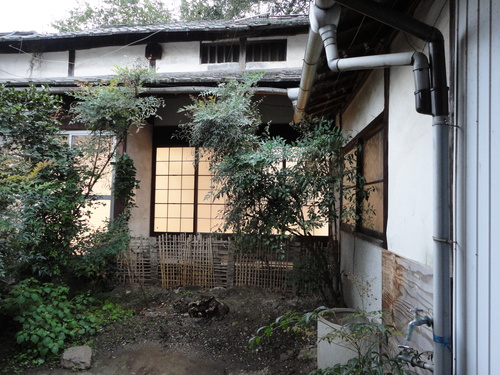
Sea Vine building looking very inviting on a dark day.
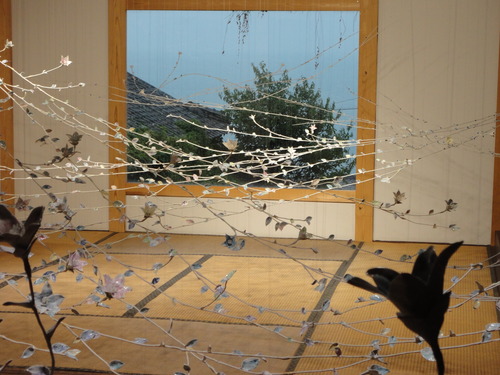
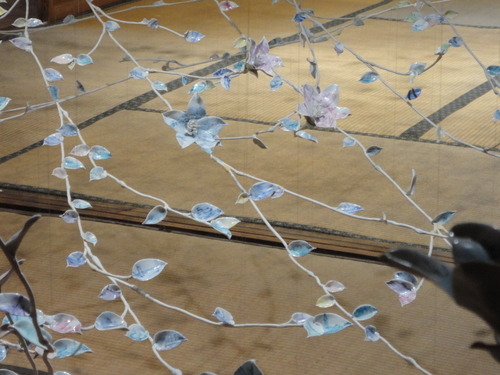
Sea Vine in the light

Organ in the rain

View from Urushi House
We ended our trip at Onba Factory where volunteers were packing away the Onba Works for the winter.
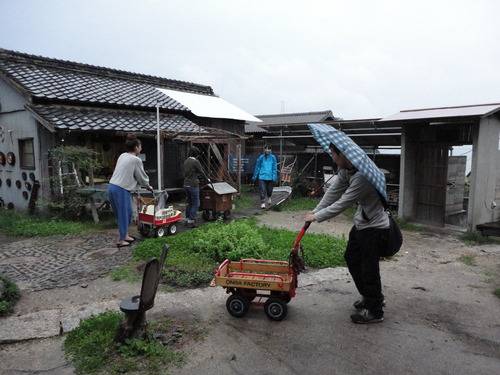
Inside, however, we heard great news. Yasufumi Oshima, chief of the Onba Factory team, had just been awarded the Takamatsu City Cultural Incentive Prize, which he very much deserves! We also found a new onba.

A replica of a catamaran that is currently being used by volunteers to clean up the beaches of the area's islands. Here's the real thing.

It can also be rented with the driver for day trips around the Seto Inland Sea. We got a lift home on it, which was really nice!! It's a totally different experience being so close to the water.


Although the art sites are closed for the winter to undergo maintenance and give the artists and volunteers a bit of a break, there are still fun activities being planned with the Ogjima community. Check out the website below (in Japanese) if you're interested. (If you can't read it but are coming for a visit, let me know and I'll tell you what's going on.)
http://www.ogijima.jp/sitemap/
Ogijima in the rain, looking wet but still beautiful.
We arrived in mid-afternoon just as 130 people were leaving. Apparently there had been a big event with hoards of kids and families reminiscent of Art Setouchi in 2010. The onba market was out with local women selling food and handmade crafts from their custom-made art buggies.
Onba Market
We bought octopus rice, tempura and soybeans – all excellent and reasonably priced. The men were selling local fish, octopus and crabs, live!
Local crabs
I caught this man butchering an octopus on the spot for a customer.
According to him, octopi have several hearts so they don't die very easily. This one tried to escape up the butcher's leg despite being partly butchered already.
It didn't succeed. A pretty gruesome business really. We bought live crabs instead and cooked them when we got home. These local crabs can't be bought in stores because select restaurants that know how good they are buy them up. They were delicious but cooking them live was still a bit gruesome.
Cooked crab.
After shopping, we wandered through the now familiar lanes to the art sites. Arriving at Dream Friends, we were delightfully surprised to find the art space transformed by the works of a local artist named Tadataka Mizutani.
I'm not sure how much comes through from these photos, but the vivid greens and blues in the white washi-papered setting seemed to mirror the colors of the outer world, drawing us inside. It was quite magical.
The above are from a stunning series of mirror image photos made for the 2003 Kyoto World Water Forum. Below are some of Mizutani’s graceful stainless steel sculptures.
His wife happened to be there and she told us that he had submitted a proposal to Art Setouchi 2010 but had passed away a year before the festival at only 54 years of age. This was a beautiful tribute to his work.
Another pleasant surprise for us was Sea Vine. Being a gray day, they had turned the lights on in the building. It was the first time I had ever seen it lighted.
Sea Vine building looking very inviting on a dark day.
Sea Vine in the light
Organ in the rain
View from Urushi House
We ended our trip at Onba Factory where volunteers were packing away the Onba Works for the winter.
Inside, however, we heard great news. Yasufumi Oshima, chief of the Onba Factory team, had just been awarded the Takamatsu City Cultural Incentive Prize, which he very much deserves! We also found a new onba.
A replica of a catamaran that is currently being used by volunteers to clean up the beaches of the area's islands. Here's the real thing.
It can also be rented with the driver for day trips around the Seto Inland Sea. We got a lift home on it, which was really nice!! It's a totally different experience being so close to the water.
Although the art sites are closed for the winter to undergo maintenance and give the artists and volunteers a bit of a break, there are still fun activities being planned with the Ogjima community. Check out the website below (in Japanese) if you're interested. (If you can't read it but are coming for a visit, let me know and I'll tell you what's going on.)
http://www.ogijima.jp/sitemap/
Posted by cathy at
23:53
│Comments(4)



